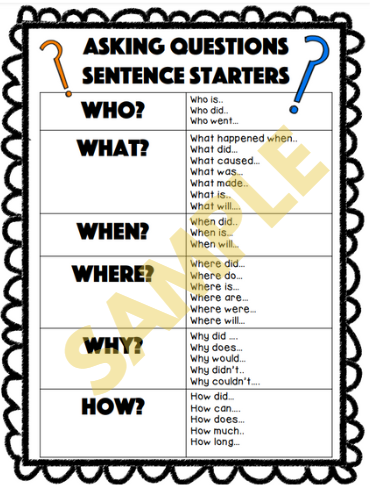Boosting reading comprehension through “ask and answer” strategies is a powerful way to deepen students’ understanding and critical thinking. By guiding students to ask insightful questions and teaching them how to refer back to the text to answer the questions, you’ll help students build comprehension. Let’s dive into five engaging, practical methods that will help your students master this essential reading comprehension strategy!
1. Review or Teach Students the Difference between a Question and a Statement
Before students can ask effective questions, they need to understand what differentiates a question from a statement. Provide examples of questions and statements, then guide students in identifying which are questions and which are statement. Pose questions such as:
- Is this a question or a statement? How do you know?
- What clues tell us that this is a question/statement?
Review question words like who, what, where, when, why, and how and create an anchor chart or supply students with a visual for reference. Clarifying this distinction prevents confusion and helps ensure students prepared to use the ask-and-answer strategy confidently.
2. Interactive Read-Aloud for Questioning Practice
An interactive read-aloud is an easy and effective way to model how to ask and answer questions using evidence from the text. Choose any short passage or picture book for the read aloud. Pause at key points in the story and invite students to ask and answer questions about the book. Look for evidence within the text together.
Ask questions such as:
- How did you know?
- Where in the text did it tell you?
- Is this a question I can answer with the text? Why or why not?
- What is a question that I can ask about this page? Is there another question I can ask?
Disclaimer: This post may contain affiliate links, which means I may earn a small commission at no extra cost to you if you make a purchase through these links. I only recommend products and resources that I believe will add value to your teaching experience. Thank you for supporting my blog!
3. Use Question Stems to Encourage Deep Thinking
Provide students with question stems that encourage higher-order thinking. Sentence starters like “Why did…?”, “Who…”, and “What caused…” prompt students to look deeper into the text for answers. Encourage students to use these stems as they work independently or in pairs.
Students often feel more confident when they have a starting point, especially for more complex texts. This approach helps even reluctant readers feel successful in formulating questions and hunting for answers.
4. Partner Practice
Sometimes, just having a partner to work with can make all the difference. Offer partner work as a choice for students to practice asking and answering questions using a passage or a book. This gives them a low-stakes way to share ideas, get feedback from classmates, and clarify their thinking.
Encouraging peer-to-peer discussion not only builds communication skills but also makes the reading comprehension process a social and interactive one.
5. Use Graphic Organizers
Graphic organizers can be very helpful in guiding students to organize their questions and find supporting evidence. For example, a T-chart with one column for questions and another for evidence lets students clearly see the connection between their inquiry and the text.
These tools help students organize their thoughts, follow the logical flow between questions and answers, and focus on finding specific, relevant information. Graphic organizers are especially beneficial for visual learners, and they provide a reference that students can review when needed. Use them with a passage, with a book at students’ reading level, an e-book, or a book of student’s choice.
6. Practice, Practice, Practice!
Spend at least one week practicing the skill. Make it a habit to revisit learned skills throughout the year as your students learn new skills.
If you are looking for more ask and answer reading skill resources, check out this resource from my TPT store!











